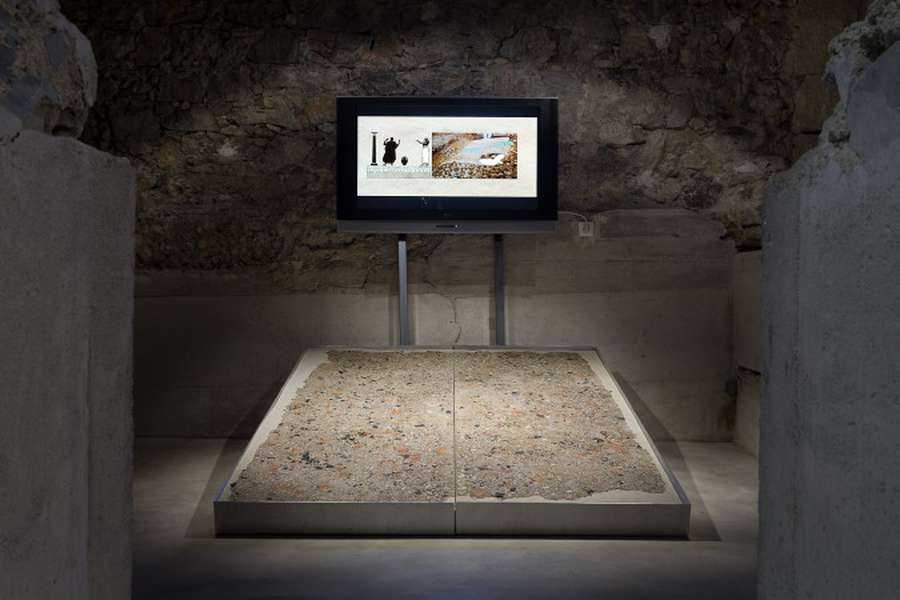A Roman pavement beneath Slovenska cesta
In the Treasury of the City museum of Ljubljana do not miss recently discovered and just conservated Roman pavement from beneath Slovenska cesta, made in opus signinum technique.
Heritage of Emona in the centre of Ljubljana
During renovation of municipal infrastructure along the section of road between Šubičeva ulica and Aškerčeva cesta in Ljubljana, extensive archaeological research was carried out from September 2015 to March 2016. The location is part of an archaeological site that has been proclaimed a cultural and historical monument and thus guarantees special protection to an area of Roman Emona (Aemona). A field team from the Museum and Galleries of the City of Ljubljana (MGML), flanked by archaeologists from Skupina STIK, supervised the progress of the building work and carried out investigations in the sections where the work was taking place.
Following the removal of modern strata, which reached down to a depth of 1.2 m, it was found that the entire section containing remains from Roman Emona was remarkably well preserved.
In the light of previous experiences with locations with modern utility pipes and lines running through them, the good state of conservation of the heritage was a considerable surprise. Of particular interest was the area in the section of Slovenska cesta between the present-day Rimska cesta ("Roman Road") and Aškerčeva/Zoisova cesta, where a previously little known area of the southern arm of Emona's main street was uncovered and investigated.
Notable within the complex built fabric of this area is a section of living quarters from an independent dwelling of the atrium type. In the first century AD this building consisted of an entrance section with partly wooden partition walls and an atrium section. Opening off the atrium – a rectangular court – were rooms paved with high-quality mortar pavements constructed using the opus signinum technique and frequently restored. At the proposal of the field team and conservators from the Ljubljana regional unit of the Institute for the Protection of Cultural Heritage of Slovenia (ZVKDS), it was decided to preserve, conserve and musealise the pavements.
—Martin Horvat, Head of Archaeological Excavations, MGML
What is opus signinum and where does it originate?
The exhibited pavement was made using the opus signinum technique: a mixture of brick fragments, stones, sand and water beaten down onto a base. The name opus signinum literally means "work from Signia". Signia, present-day Segni, was a town in central Italy famous for its bricks. These bricks, smashed into fragments, were also used to make pavements.
This method of decorative paving was used in the Roman Empire for various rooms in private houses and public buildings, alongside the better known and more expensive mosaic pavements. Opus signinum was particularly widespread in the African provinces, where it also originated in around the middle of the third century BC. Pliny the Elder mentioned it in his Natural History, describing it as one of the hardest building materials. It also had one other very useful property: it was watertight.
Pavements of the opus signinum type are not uncommon in Emona but little attention has been paid to them, since the focus has been more on mosaic pavements. Unfairly so: opus signinum is an important document of its time and place and evidence of the skill of Roman builders. The pavement from Slovenska cesta – made from fragments of brick, a wide variety of stone (dolomite, limestone, flint and sandstone), river sand and a lime binder – was decorative and durable, and almost as hard as concrete.
—Bernarda Županek, PhD, Curator for Roman Antiquities, MGML
Conservation-restoration report
We began conservation-restoration procedures at the archaeological site itself, where we cleaned the surface of the pavement, protected it and reinforced it with a temporary support. We then separated the pavement from its base and, still on the spot, removed part of the superfluous plaster on its reverse side. The pavement was too big to be transported and worked on at the Restoration Centre so we divided it into six smaller pieces.
Back at the Restoration Centre we mechanically cleaned the reverse of the pavement, thinned it further and consolidated it with a protective layer of mortar. We then additionally reinforced it with dowel rods, which together with a bed made from polyurethane foam create a base for the pavement. The next stage was the removal of the temporary support and the protection that we applied to the surface of the pavement before lifting it. We removed dirt and traces of glue from the surface of the pavement. Filling and reconstruction were also carried out in areas of visible damage. We then assembled the pieces of the pavement and transferred them to two separate supports, which together form a whole. Next we designed a decorative plaster and retouched the fillings.
Conservation-restoration work was also carried out on two other pavements besides the exhibited pavement.
—Petra Benedik and Jelka Kuret, Restoration Centre of the Institute for the Protection of Cultural Heritage of Slovenia (ZVKDS)
Location
Gosposka 15
1000 Ljubljana
Information and reservations:
T: +386 1 2412 500
T: +386 1 2412 506
E- mail: info@mgml.si, prijava@mgml.si
Opening hours
Tuesday–Sunday: 10.00–18.00
Mondays, 1 January, 1 November and 25 December: Closed
Tickets
Permanent exhibition Ljubljana. History. City. (basement and 2nd floor)
Solo visit: € 8 / reduced (children from the age of 7, students, over 60, unemployed, disabled): €6
Family ticket: 18€
Public guided tour: € 9.00 / reduced: € 7.00
Children up to the age of 6, ICOM, PRESS, SMD, disabled companions, tourist URBANA, licensed tourist guide: free of charge
